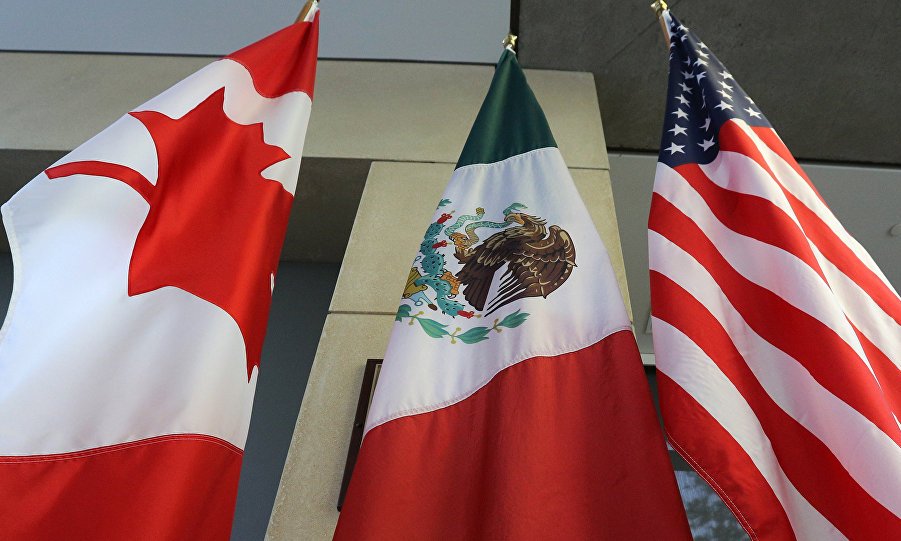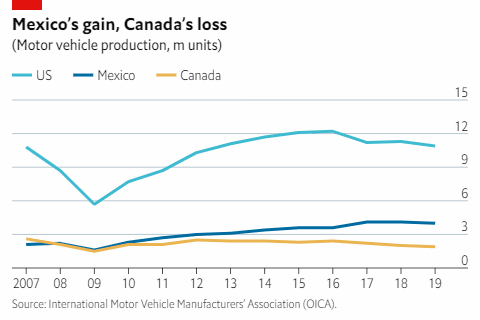Last Updated on February 27, 2024

In the ever-evolving landscape of global trade agreements, the United States-Mexico-Canada Agreement (USMCA) stands as a pivotal milestone in American manufacturing. In this comprehensive article, we will explore the USMCA impact on American manufacturing. We will highlight its key differentiators from its predecessor NAFTA, emphasising the particular relevance of its partnership with Mexico. This treaty, which came into effect in July 2020, has ushered in an exciting era for American manufacturers. It has reshaped their business practices and set the stage for unprecedented growth.
The Genesis of USMCA
Before we dive into the tangible benefits, let's briefly examine the genesis of USMCA and its stark differences from NAFTA.
The Transition from NAFTA to USMCA
The North American Free Trade Agreement (NAFTA), implemented in 1994, served as the framework for trade relations between the United States, Mexico, and Canada for over two decades. However, NAFTA required a significant overhaul to address international trade dynamics.
Addressing NAFTA's Shortcomings
NAFTA was often criticized for its lack of provisions in areas such as labor rights, environmental protection, and intellectual property. The USMCA sought to remedy these shortcomings by introducing modern regulations.
The reestablishment of pre-NAFTA trade barriers would not only make certain goods more expensive for consumers—a burden that falls more heavily on the economically disadvantaged—but also hit several politically sensitive sectors harshly.
Foreign Policy Research Institute
The USMCA: A New Chapter in Trade
The USMCA emerged as a meticulously crafted agreement, designed to foster fair trade, promote job growth, and strengthen American manufacturing. Unlike NAFTA, it incorporates innovative provisions more attuned to manufacturers' needs.
Boosting American Manufacturing
Streamlined Supply Chains
The USMCA has played a pivotal role in streamlining supply chains for American manufacturers. By minimizing trade barriers and reducing tariffs, it has facilitated the movement of goods and materials between the United States, Mexico, and Canada. This simplification has allowed manufacturers to optimize their operations, leading to increased efficiency and cost savings.
Job Creation
One of the most significant advantages of the USMCA is its potential to create jobs within the American manufacturing sector. By incentivizing domestic production, this agreement encourages businesses to invest in local talent and infrastructure. The result is a surge in employment opportunities, benefitting both skilled and unskilled workers.
Market Expansion
Expanding markets is a cornerstone of USMCA. With a combined GDP of over $25 trillion among the three countries, this agreement opens doors for American manufacturers to access an even broader customer base. This increased market access has the potential to drive unprecedented growth in American manufacturing exports.
Strengthening Intellectual Property Rights
One significant USMCA impact on American manufacturing is the enhancing intellectual property rights. This move has provided greater protection for American businesses, particularly in industries that heavily rely on intellectual property, such as pharmaceuticals and technology.
Stricter Rules of Origin
Under the USMCA, various industries have stricter origin rules, particularly the automotive sector. This has led to more parts being manufactured in the United States and Canada, benefitting American workers.
The Mexican Partnership
The Vital Role of Mexico
Mexico has emerged as a pivotal partner in the USMCA success. Its geographical proximity, combined with its skilled labor force, positions it as a critical ally for American manufacturers looking to expand operations and reduce production costs.
Mexico has many advantages; perhaps most important is proximity to the US and its integration into the US economy under NAFTA since the 1990s. Goods can arrive much more quickly by land rather than dozens of days at best crossing oceans. NAFTA had already built some integrated—or at least more closely linked—supply chains. Many Americans speak Spanish and Mexicans English, making business ties easier; it has a strong industrial base and lower labor costs.
Committee for Economic Development
Increased Cross-Border Trade
The partnership with Mexico has led to a surge in cross-border trade. The USMCA's provisions for duty-free access to Mexican markets for American goods have been a game-changer for many businesses. This reciprocal relationship fosters economic growth on both sides of the border.
The Automotive Industry Impact
The automotive sector is one of the most significant beneficiaries of the USMCA-Mexico partnership. Manufacturers in both countries have strengthened their ties, leading to increased cooperation and investment. This has resulted in a more competitive North American automotive industry that can better withstand global competition.

Leveraging the USMCA-Mexico Connection
The USMCA strengthens trade ties between the United States and Mexico, making it an even more attractive destination for American manufacturers. The removal of uncertainties related to trade agreements has encouraged investment in Mexican manufacturing facilities.
Conclusion
In conclusion, the USMCA has revitalized American manufacturing and set it on a path of sustained growth and competitiveness. Its departure from NAFTA, with a focus on modernization and inclusivity, has proven to be a visionary move. The partnership with Mexico, in particular, has paved the way for increased economic prosperity and cross-border collaboration.
The USMCA is not just a trade agreement; it's a testament to the enduring spirit of innovation and cooperation that defines North American manufacturing. As we move forward, the USMCA impact on American manufacturing will continue to redefine its role on the global stage.
FAQs
Q: How does the USMCA differ from NAFTA?
A: The USMCA addresses shortcomings in NAFTA by incorporating provisions related to labor rights, environmental protection, and intellectual property, making it a more comprehensive and modern trade agreement.
Q: What impact has the USMCA had on job creation in the manufacturing sector?
A: The USMCA has the potential to create a significant number of jobs in the American manufacturing sector by encouraging domestic production and investment in local talent and infrastructure.
Q: How has the partnership with Mexico influenced American manufacturing?
A: The partnership with Mexico has led to increased cross-border trade, particularly benefiting industries like automotive manufacturing, and has strengthened economic ties between the two countries.
Q: What benefits does the USMCA offer to American exporters?
A: The USMCA provides American manufacturers with expanded market access, duty-free access to Mexican markets, and streamlined supply chains, enhancing their ability to export goods and compete globally.
Q: How has the USMCA contributed to the growth of the North American automotive industry?
A: The USMCA has fostered increased cooperation and investment between American and Mexican manufacturers in the automotive sector, resulting in a more competitive North American automotive industry.
About NovaLink
As a manufacturer in Mexico, NovaLink employs a unique approach that transcends the traditional model of shelter production. More than just the location of your manufacturing, we would like to become a partner in your manufacturing in Mexico. You will be able to relocate or initiate manufacturing for your company in Mexico in a low-cost labor environment with very little delay or up-front costs. Find out how we can help you by handling the manufacturing process.
There are NovaLink facilities in the border cities of Brownsville, Texas, Matamoros, Mexico, and Saltillo, Mexico.